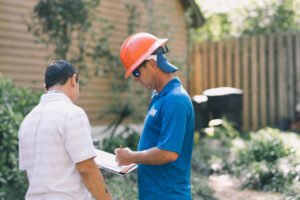Your roof goes through a lot each year: spring rains, summer heat, fall storms, and winter’s cool spells.
But did you know that with just a few seasonal check-ups, you can catch potential problems before they become costly repairs?
In Florida’s unique climate, keeping up with your roof’s seasonal needs can mean the difference between a few easy fixes and a major overhaul. Ready to find out what your roof needs each season to stay in top shape? Let’s dive into the essential steps for year-round roof care.
Key Takeaways:
- Seasonal roof care helps catch small issues before they turn into costly repairs.
- Simple, seasonal check-ups can add years to your roof’s lifespan and protect your home.
- Professional inspections ensure your roof is always prepared, whatever the season.
- Don’t wait for problems. Stay proactive to keep your roof and home, safe year-round.
Spring (March – May): Inspect and Refresh
As the weather warms up in spring, it’s the perfect time to inspect your roof for any damage left over from winter’s cool spells and prepare for upcoming summer rains.
Florida’s early spring storms can quickly reveal any weak spots in your roof, so it’s a great time to tackle some essential maintenance.
- Inspect for Winter Damage
Even though Florida’s winters are mild, colder nights can still affect roof materials. Check for loose or missing shingles and make sure everything is secure before summer storms roll in.
- Clean Gutters and Downspout
Spring storms can bring sudden bursts of rain. Make sure your gutters and downspouts are clear of leaves and debris so water flows smoothly and doesn’t pool near your roof.
- Trim Overhanging Branches
Spring is the season for new growth, so trim any branches near your roofline. This will help prevent branches from scraping or falling onto your roof during windy storms.
Spring Roof Maintenance Checklist
| Task | Why It’s Important | Description |
| Check for Loose or Missing Nails | Prevents shingles from lifting during storms | Walk along the edges of your roof (or inspect from ground level with binoculars) to spot any missing or loose nails. |
| Inspect Chimney Flashing | Ensures a watertight seal around chimneys, a common area for leaks | Look for any gaps, cracks, or rust around the chimney flashing and reseal or replace if needed. |
| Test Attic Ventilation | Keeps air circulating, preventing moisture buildup that could damage roofing materials | Place your hand near vents to feel for airflow; poor airflow may mean it’s time to clean or adjust vents. |
| Examine Fascia and Soffits | Identifies rot or damage caused by winter moisture | Look for any soft spots, discoloration, or visible mold that could indicate moisture damage. |
| Wash Off Debris | Removing debris like leaves or moss reduces wear on shingles and prevents water buildup | Use a gentle hose to wash off leaves or dirt, avoiding high pressure to protect shingles. |
Summer (June – August): Prep for Heat and Storms
In Florida, summer is all about high heat and intense rainstorms. These months bring daily afternoon showers and even hurricanes, so preparing your roof for peak summer conditions is essential.
- Inspect and Clean Roof Vents
Proper attic ventilation is crucial during Florida’s humid summers. Make sure your roof vents are clear, as poor ventilation can lead to moisture buildup, which invites mold and weakens your roof.
- Check for Moss and Algae Growth
Florida’s warm, damp climate is a paradise for moss and algae. Watch for any green or dark spots on your roof and remove them as needed. Algae-resistant shingles or professional cleaning can help.
- Look for UV Damage
The Florida sun is no joke! Shingles can become brittle or fade due to UV exposure. Here are some signs to take a look at:
| Symptom | Description | Potential Solution |
| Cracked shingles | Shingles dry and split from the sun | Consider shingle replacement |
| Fading or discoloration | Loss of roof color due to UV rays | Use a UV-protective coating |
| Loose flashing | Flashing becomes brittle and loosens | Reseal or replace flashing |
- Secure Flashing and Sealants
Summer storms can get intense. Inspect the flashing and sealants around chimneys, skylights, and vents to ensure they’re secure, so your roof is ready for heavy rain and wind.
Fall (September – November): Prepare for Winter and Late-Season Storms
Fall is still storm season in Florida, and with cooler months around the corner, it’s a good time to get your roof ready for whatever’s next. September can bring the tail end of hurricane season, so don’t skip these tips:
- Check Roof and Attic Insulation
Good insulation is key for managing indoor temperatures year-round and prevents moisture issues that can lead to mold. Check insulation now to ensure it’s sufficient.
- Inspect Gutters and Downspouts
Florida trees can drop a surprising amount of leaves in the fall. Clean your gutters to keep water flowing freely and avoid potential blockages that could lead to water buildup.
- Look for Signs of Leaks
Keep an eye out for water stains on ceilings or walls after heavy fall storms. Spotting leaks early can prevent bigger issues and keep your roof in good shape for winter.
- Inspect Roof Flashing
Flashing helps direct water off your roof, especially around areas like chimneys or skylights. Make sure it’s intact to keep your roof protected from potential leaks during late-season storms.
Winter (December – February): Monitor and Maintain
Winter in Florida may not mean snow, but it does bring cooler temperatures, morning frost, and even occasional heavy rain. Winter roof care is all about monitoring for any issues and addressing them quickly.
- Safely Remove Debris
Winter’s cooler weather can cause small branches and debris to fall. Clear off any debris that may have landed on your roof to prevent buildup and moisture retention.
- Monitor for Condensation
With temperatures fluctuating, condensation can sometimes form in the attic. Proper attic ventilation can help manage moisture and prevent mold from growing.
- Inspect After Winter Storms
Occasionally, winter can bring heavy rainfall or sudden wind gusts. Take a moment to visually inspect your roof from the ground for any signs of damage after a storm. If you see anything concerning, call a professional to assess it.
- Be Mindful of Coastal Salt Exposure
Florida’s coastal homes face additional challenges from salt exposure, which can corrode metal fastenings, flashing, and even gutters. If you live near the coast, consider periodic rinses of metal parts with fresh water to remove salt buildup and reduce the risk of corrosion.
Year-Round Roof Care Made Easy with Tadlock Roofing
Seasonal roof care is key to keeping your Florida roof strong and ready for any weather. By taking a few steps each season, such as prepping for the summer heat and clearing out gutters before fall storms, you can prevent damage and keep your roof lasting longer. Tadlock Roofing is here to answer any questions, provide inspections, or assist with repairs—all year long. Ready for a check-up or need some expert advice? Give us a call at 855-694-7376 or fill out our online form to keep your roof strong and your home safe!










